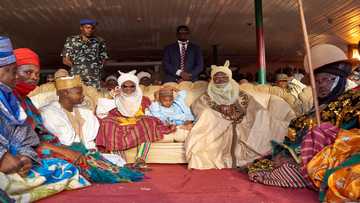Dagaare: basic phrases and interesting facts
Learning a new language can be daunting. It is not only hard to learn how to master the alphabet, but also how to correctly pronounce the words. Most new language learners have been known to give up when it comes to learning specific styles in Ghana. Ghana is a country rich in writing and communication styles, culture, food, and other aspects. However, despite there being so many notions about the complexity in language, there is one style that is quite effortless to learn. This is none other than the Dagaare language.

Source: Instagram
Are you looking for a guide to help you be more familiar with the Dagaare style in Ghana? Look no further. We have compiled some of the most exciting things you need to know about this incredible style.
READ ALSO: Okyeame Kwame challenges gov't to make local languages requirement for tertiary institutions
Exciting details about the Dagaare language

Source: Instagram
Here are the incredible things you need to know about the Dagaare language:
1. Dagaare is part of the Gur, which is a branch of the languages of the Niger-Congo. It is spoken not only in Ghana but also in Burkina Faso. It is estimated that over one million individuals in these two countries speak this language.
2. Dagaare style can be classified into three sections. These include:
- Southern Dagaare- Roughly seven hundred thousand people speak this style in Ghana. These people are situated in the area of the Upper West and also in the northwest corner of the country.
- Northern Dagara-The northern Dagara is primarily spoken by close to three hundred and eighty-eight thousand people in Burkina Faso. These people are located in the Bougouriba, Poni, Mouhoun, Sissili, and the Southwest provinces. Here, the style is also referred to as Dagati, Dagaari, Dogaari, Degati, Dagari, or Dagaare.
- Dagaari Dioula-This language is spoken primarily by an estimate of twenty-one thousand individuals in Burkina Faso in Hamele, Soukoulaye, Wessa, Diébougou, Gao, To, Leo, Boromo, French, Pa, Silly, Fara, Dano, and Dissin. Dagaari Dioula is greatly influenced and impacted by a language known as Dioula. People also refer to Dagaari Dioula as Wala, Dagaari Jula, Yari, Dagari Dyoula, and Jari.
3. In general, people also refer to the Dagaare style as the Dogaari, Dagati, Dagaare, Dagari, Degati, or the Dagara.
4. In Burkina Faso, Dagaare was written first by the colonial administrators. They used the language to document the names of both human beings and places. When the French missionaries arrived in the country around 1950 and 1960, they used the style to write their religious literature. They used a French spelling mechanism. Since then, this language has undergone so many reforms and improvements. The modern orthography can be attributed to being conducted in 1998. In Ghana, the Dagaare Language Committee played a significant part in publishing a Guide to Dagaare Spelling back in 1976. It was later revised in 1982.
5. When it comes to pronunciation, three significant tones are used. One of them is the high tone, which is identified by an acute accent (á). The second one is the low tone which tends to have a grave accent (à). The last one is the middle tone, which does not contain any mark whatsoever. The tones used in the Dagati of Ghana are also different. The mid-tones tend to be unmarked, while the nasal vowels tend to be recognized by a tilde (˜).
6. Another exciting fact that most people do not know about this language is about its dialects. Some linguists have researched and classified the Dagaare language as part of a dialect continuum that also comprises of Birifor and Waale. Most people always tend to confuse between Birifor and Dogaari. However, the two styles are different. Dogaari is more social and politically prominent when compared to Birifor.
7. There are various religions practiced by the Dagati community. The two major religions are Christianity and traditional religion.
Example of a text in Dagaare

Source: Instagram
There is always a curious individual who may not be familiar with the Dogaari style but would still like to know some phrases that would appear in this unique style. We have seen people nowadays post in their social media pages phrases in different styles than we are used to hearing them speak. Although sometimes they are misinterpreted and viewed as people who only post cryptic messages, this is not always their goal. Most of them only have the desire of sharing new alphabet features in a newly learnt or identified language.
Here is an example of a text in the Dogaari style:
- Nengsaala zaa ba nang dɔge so la o menga, ka o ne o taaba zaa sengtaa noba emmo ane yɛlɛsoobo sobic poɔ. Ba dɔgɛɛ ba zaa ne yɛng ane yɛlɛ-iruu k'a da seng ka ba erɛ yɛlɛ korɔ taa a nga yɔɔmine.
When this text is interpreted in English, it means the following:
- All people are born with freedom and with equal rights and dignity. They have conscience and reasoning and should try to act towards each other in a brotherhood spirit.
Dogaari, also known as Dagaare is a style that is quite common not only in Ghana but also in Burkina Faso. It has been highly embraced in these two countries and has become a native language for the two nations. Although most people would expect the style to be the exact same in the two countries, it, however, slightly differs. One of the primary differences is seen in the tones during the pronunciation. Pronunciation of some vowels, for instance, varies in these two countries. Nevertheless, this language is effortless to learn and quite captivating to speak.
READ ALSO: Ghana and Rwanda become star example for Africa on Pan-Africanism
Source: YEN.com.gh





